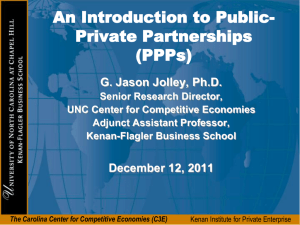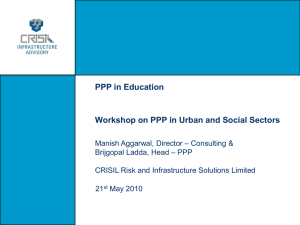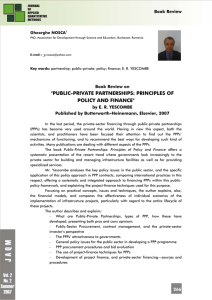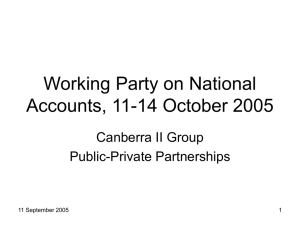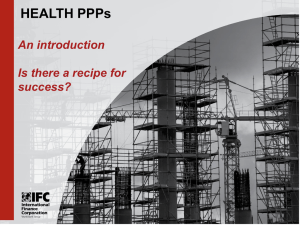Public-Private Partnerships: some lessons from global experience Assessing global
advertisement
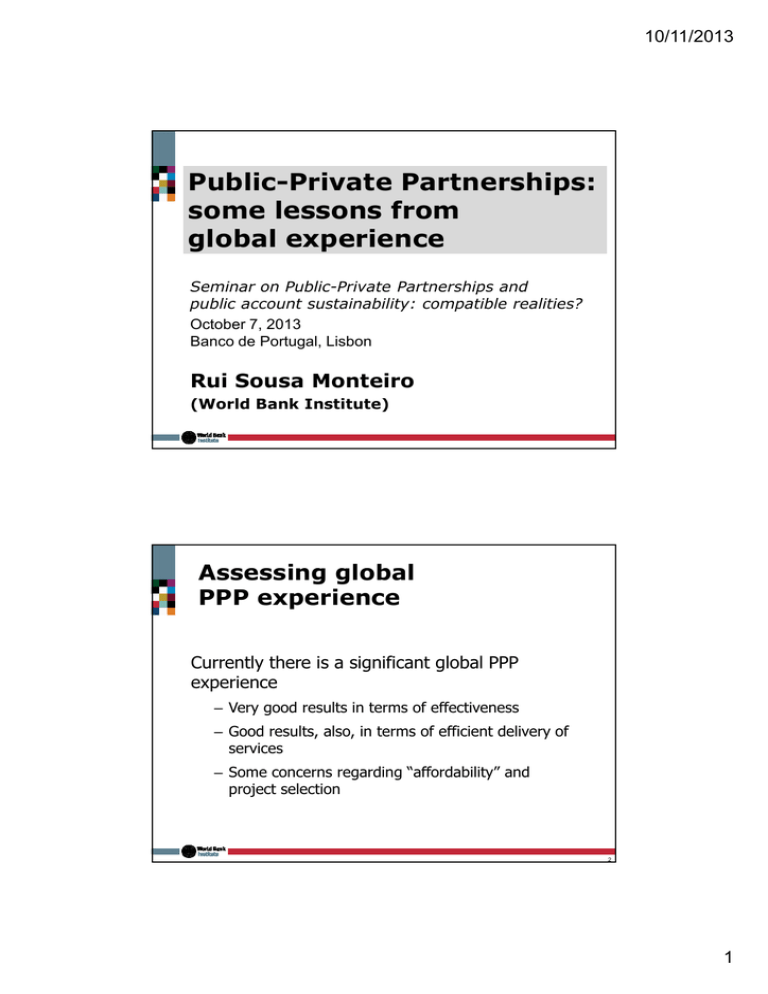
10/11/2013 Public-Private Partnerships: some lessons from global experience Seminar on Public-Private Partnerships and public account sustainability: compatible realities? October 7, 2013 Banco de Portugal, Lisbon Rui Sousa Monteiro (World Bank Institute) Assessing global PPP experience Currently there is a significant global PPP experience – Very good results in terms of effectiveness – Good results, also, in terms of efficient delivery of services – Some concerns regarding “affordability” and project selection 2 1 10/11/2013 What do we call PPPs? 3 What is a PPP Public-private partnerships (PPPs) are long-term contractual relationships between a public sector entity and a private sector entity The private partner commits itself to providing a set of services according to some specified performance levels The public partner monitors the performance and pays the services or grants the private partner the right to collect fees from users Economic reasoning tells us that PPPs should only be used for services that require long-life assets 4 2 10/11/2013 Rationale for PPPs Tradit. D-B PPP PPP PPP PPP design of infrastructure core construction of infrastructure maintenance of infrastructure provision of equipment maintenance of equipment provision intermediate services provision services to end-users In each case, services provided according to public sector rules 5 PPP and public service • In locking the private partner in a long-term relationship, the public sector is also locked for a long period • Because PPPs relate to public service, the public partner is very sensitive to service disruption, giving the private partner added bargaining power • When change affects the project, the private partner may benefit from it; the private partner may even engage in strategic moves for inducing change for its own benefit 6 3 10/11/2013 Foundations of PPP efficiency • Output-based long-term contracts: – Core: design + construction + maintenance – Performance-based payments whole-life costing • Private capital at stake credible commitment • Good project selection (CBA, VFM, affordability) • Competitive procurement • Adequate contract management – Partnering – Contract enforcement – Prevention of strategic moves 7 Is the PPP experience relevant? 8 4 10/11/2013 Were the Egyptian pyramids PPPs? 9 Initial PPP experience: large programs Worldmapper.org © Copyright SASI Group (University of Sheffield) and Mark Newman (University of Michigan) 10 5 10/11/2013 Initial PPP experience: proliferation Worldmapper.org © Copyright SASI Group (University of Sheffield) and Mark Newman (University of Michigan) 11 Current PPP experience: new large programs Worldmapper.org © Copyright SASI Group (University of Sheffield) and Mark Newman (University of Michigan) 12 6 10/11/2013 Current PPP experience: proliferation Worldmapper.org © Copyright SASI Group (University of Sheffield) and Mark Newman (University of Michigan) 13 Current PPP experience: countries with PPP programs Worldmapper.org © Copyright SASI Group (University of Sheffield) and Mark Newman (University of Michigan) 14 7 10/11/2013 Basis for PPP efficiency long-term contract with effective risk transfer requires demand-based or availability-based credible long-term risk transfer requires private capital at stake, no easy way out keeping efficiency in the long term requires proper contract management and oversight of fiscal risks but, most of all, PPP efficiency requires good project selection, identifying costs, benefits & risks 15 Why do we need PPPs? 16 8 10/11/2013 Public infrastructure but often affected by basic for economic growth and for the quality of life poor maintenance ▪ The (non-PPP) case of Lima metro, Peru The 7-station elevated metro, equipped with 32 cars, was officially opened in 1990 but never operated, due to poor demand; its operation started only 21 years later, after enlargement to 16 stations. The planned 2nd line will be a PPP ! 18 9 10/11/2013 The case of Joá Penteado tunnel 2, Brazil The 300-meter tunnel was inaugurated in 2009, 23 years after the beginning of construction. Linking downtown Campinas (in São Paulo state) to its industrial district on the other side of a hill, its construction stopped after one year, for lack of public funds, when the tunnel was half dug; it took 20 years to obtain funds for digging the remaining 130 meters. 19 The case of Salvador da Bahía metro, Brasil Half-built and not operational for 12 years, completed 2012 and still not operational. 20 10 10/11/2013 The (non-PPP) case of Barcelona subway line 9, Spain Cost forecasts: €2,600m in 2003; then €3,700m; later €6,900m; currently €16,000m; beginning of construction: 2003; end of construction: unknown (for lack of financing) 21 A non-PPP case: Requena-Utiel HSR station, Valencia, Spain Cost: €12m; surrounded by vineyards, midway between Requena and Utiel; demand is slowly growing, having reached 50 passengers/day 22 11 10/11/2013 The (non-PPP) case of Cuenca HSR station, Spain Cost: €20m; the first “green” rail station in Spain: noncontaminant materials, geothermal water supply; 250-car parking; demand is so low that Renfe suppressed a few trains 23 The case of Laredo marina, Spain Cost €90m (half of that still owed to the banks by Municipality), but still incomplete; no users; locals complain the beach nearby is being eroded by the changes in sea currents 24 12 10/11/2013 The case of the marina of Lugar de Baixo, Madeira (1) Initial expected cost €24m; current cost €44m according to regional gov’t (or €100 according to the opposition); opened in 2004, with berths for 291 yachts; destroyed in 2005 25 The case of the marina of Lugar de Baixo, Madeira (2) 26 13 10/11/2013 The case of the marina of Lugar de Baixo, Madeira (3) 27 Casa da Música, Porto, Portugal House of Music, Porto, Portugal, €100m 28 14 10/11/2013 Ciudad de las Artes y las Ciencias City of Arts and Sciences, Valencia, Spain, $500m 29 The (non-PPP) case of Jaén tram, Spain Cost: €100m, completed in 2011, procured by the regional government, then transferred to the municipality, who operated the service for two weeks and closed it for lack of funds to operate a tram service with scarce users (even with zero fee) 30 15 10/11/2013 The case of Ciudad Real airport, Spain Cost €1,100m; 4,000m runway; the first private international airport in Spain; capacity: 2,500,000 pass; demand in 2010: 33,520; closed in April 2012 after three years in operation 31 The case of Huesca airport, Spain Cost €40m; opened in 2007; with no commercial activity since February 2011; demand: zero passengers August 2011, four in September, all from small private planes 32 16 10/11/2013 The case of Castellon airport, Valencia, Spain Cost: €150m; officially declared “open” in March 2011; not licensed due to design errors; a $375,000, 79-feet tall statue of Carlos Fabra, a local politician, was erected in the airport 33 The case of Pamplona-Noáin airport, Spain Cost €50m; capacity for 1,100,000 passengers/year; demand in 2010: 291,553 34 17 10/11/2013 The case of León airport, Spain Three times enlarged in the past decade; after the last enlargement, costing €29m, it presents capacity for 500,000 passengers, i.e. 5 times current demand 35 Spanish “ghost” airports (“aeropuertos fantasmas”) • Spain has more international airports for commercial flights than any other country in Europe: 48 public and 2 private • 20 of those airports handle fewer than 100,000 passengers/year • Too many airports? (And also too many rail lines, ports, and highways? And too many sport and entertainment facilities?) • Or were they simply built in the wrong location, in order to serve local politicians’ interests? 36 18 10/11/2013 PPP projects: Highways in Spain Significant cost overruns, in some cases over 50 percent; low demand, reaching 1/10 of expected traffic. In 2012, AP41 Madrid-Toledo, Radial 4R4, and Cartagena-Vera concessionaires filed for bankrupcy. Several more are close to bankrupcy. 37 The empirical evidence: unintended consequences • 38 19 10/11/2013 The empirical evidence A • • • • • large track-record of poorly managed projects: Poor project selection Cost overruns Insufficient demand Collapsed and struggling projects Insufficient governance But also examples of well managed projects (many of them PPP projects) And mixed cases of great service effectiveness (users ☺) and poor use of public resources (taxpayers ) 39 We have hundreds of successful PPP projects Worldmapper.org © Copyright SASI Group (University of Sheffield) and Mark Newman (University of Michigan) 40 20 10/11/2013 Chile is an example 41 And also a few successful non-PPP projects Worldmapper.org © Copyright SASI Group (University of Sheffield) and Mark Newman (University of Michigan) 42 21 10/11/2013 Øresund bridge, between Sweden and Denmark • Cost: $5700m • User-fees will repay the bridge until 2035 43 The new railway station in Stuttgart (Germany) (1) 44 22 10/11/2013 The new railway station in Stuttgart (Germany) (2) • Original cost estimate: €3100 million. • In December 2009, Stuttgart21 project approved (by Deutsche Bahn and the federal, state and municipal governments) with a cost estimate of €4100 million, on condition that its cost does not exceed €4500 million • The approving entities (DB and governments) did commit on funding the expected cost, and on a €400 million contingency provision • Works started February 2010 45 The new railway station in Stuttgart (Germany) (3) • Cost expectation €4100m + €400m = €4500m • But currently, after three years of construction, the cost estimate reached €6800 million (with a 4-year delay) • State and municipal governments refused to provide more funds, and the Finance Ministry did consider the option of cancelling Stuttgart21 • But Stuttgart21 will be completed because the cost of cancelling the project will be higher than the cost of completing it. 46 23 10/11/2013 Stuttgart21 and fiscal risks • This Stuttgart21 project provides an example of the fiscal risks that always affect public infrastructure projects • But we should emphasize a few points: – Its budget included a provision for contingencies (in the current case, an insufficient one) – The realization of cost overruns did induce strategic behavior by all involved public entities (DB and the federal, state and municipal governments) – Besides fiscal risks, political risks are present: the opposition complained, as well as environmentalists 47 Public infrastructure and fiscal risks Bent Flyvbjerg, Nils Bruzelius and Werner Rothengatter did investigate public infrastructure all over the world and identified a tendency for cost under-estimation: managers and decision makers present low cost estimates and hide risks, in order for their projects to obtain government approval Adverse selection: "Those who provide honest estimates for projects from the very beginning have little chance of getting them off the ground“ See (2003) Megaprojects and Risk: An Anatomy of Ambition, Cambridge University Press 48 24 10/11/2013 New Berlin-Brandenburg airport • PPP option abandoned; first tender canceled • Cost: €2000m en 2006 • Completion date: 2011 €4300m + compensations 2014? 49 Rail tunnel in Leipzig • Cost: €572m €960m • Completion date: 2009 Dec 2013 50 25 10/11/2013 New North-South metro line, in Koln • Cost: €600m in 2000 €1040m • Collapse of municipal archive (€1000m damage) • Vibration in the Cathedral 51 Second rail tunnel in Munich • Cost: €2047m in November 2012, plus €500m for contingencies; but the current estimate is €2433m • Completion date: 2020 2021 or 2022 52 26 10/11/2013 Some good practices • Cost of public projects (including PPPs) is presented in the budget and fiscal reports • German governments, federal and sub-national, do not adopt the out-of-the-book approach • Large projects require co-funding schemes between different levels of government (federal, state, municipal), inducing better analysis • Provisions for risks are budgeted • Role of MoF 53 How can PPPs help? 54 27 10/11/2013 PPPs as credible commitment • PPPs present a credible commitment for implementing a transport project – project revenue is dependent on reaching the operational phase, creating a strong incentive for completion – the private partner starts the project with a full financing scheme, avoiding the usual public finance troubles 55 PPPs and economic rationality Allocating project implementation to a private entity allows for the private partner to use full economic rationality in designing and building infrastructures and in selecting and procuring equipment, services and staff And PPPs may present additional benefits… 56 28 10/11/2013 A non-standard approach: PPPs as project filtering • The case of Dublin’s metro • The case of UK’s light rail projects • The case of Fertagus rail service 57 The case of Dublin subway • Project decided in 1996 – studies by the state-owned public transport operator • In 2001, new agency – a rail procurement agency • PPP studies: – subway lines cancelled – tram lines approved (38km Luas) – Luas started operating 2004 • Subway lines (Dublin Metro) – deferred again in 2011 58 29 10/11/2013 The case of UK’s light rail 59 The case of Fertagus railway 60 30 10/11/2013 The case of Fertagus rail service • The project • The solutions • The negotiation (2004) – challenging the private operator – facing lobbies: • • • • rail-line design regulation trains safety systems 61 The case of St Barts hospital 62 31 10/11/2013 How can PPPs harm? 63 Case: Canal du Midi / Garonne “mettre en risque mon bien et mon honneur à défault de réussite et, par contre-coup, acquérant un peu de l'un et un peu de l'autre, en cas que j'en sorte heureusement” Riquet, a local tax collector, presented to Louis XIV this unsolicited proposal: building a canal connecting the Atlantic Ocean to the Mediterranean at no cost to the taxpayer or royal purse 64 32 10/11/2013 Case: Canal du Midi / Garonne Riquet was awarded a perpetuous concession in 1666, with the right to collect a special purpose new tax. The canal, built in 1666-1683, was a success, but the public partner paid two thirds of its cost. 65 Vasco da Gama bridge 66 33 10/11/2013 Skye bridge 67 Sources of fiscal risks • • • • • • • • Bad projects Poorly researched projects Bad contracts Technological or commercial change Demographic change Political or legal change Poor contract management Lack of global affordability 68 34 10/11/2013 Alternative perspectives on PPPs • PPPs may be perceived as a convenient way for some decision-makers to circumvent existing budgetary rules or • PPPs may be perceived as a way for some private firms to capture government and create long-term sources of rents 69 PPPs, rent-seeking and corruption • PPPs as a rent-seeking tool – rents extracted from users, or – rents extracted from the government • The role of MoF – project appraisal (CBA or similar) – contractual review (evaluation of fiscal risks) – project prioritization (affordability checks) • PPPs as a corruption tool • The role of transparency and external auditing 70 35 10/11/2013 Preventing and managing • • • • • • Good project appraisal Careful draft contract design Gateway processes: costs and risks The role of audit offices / courts of auditors Continuous evaluation of fiscal risks & costs Contract management 71 PPP and fiscal accountability • Budgetary costs: – certain – contingent • Budgetary risks are much more than contingent liabilities • Fiscal accountability requires much more than accounting rules – effective fiscal management – contract disclosure – contract oversight and fiscal risk management 72 36 10/11/2013 On the sustainability of non-contingent liabilities or: • The fiscal iceberg 73 Transport in Portugal: the fiscal iceberg 74 37 10/11/2013 Transport in Portugal: the fiscal iceberg Translating: – Transport expenditure (Min. Public Works) – Transport expenditure (Min. Finance) €449m €251m • Total reported expenditure 2008: €700m • Net change in assets in transport sector SOE: €2,500m to €3,000m • Net change in (out-of-budget) PPP commitments: €3,000m 75 Effectiveness and efficiency effective 76 38 10/11/2013 Effectiveness and efficiency effective 77 Effectiveness and efficiency effective efficient from the viewpoint of public purse 78 39 10/11/2013 Effectiveness and efficiency effective efficient from the viewpoint of public purse efficient from the viewpoint of society 79 Effectiveness and efficiency effective efficient from the viewpoint of public purse efficient from the viewpoint of society 80 40 10/11/2013 Sydney’s BD tunnel 81 Managing fiscal risks Fiscal risks refer to the possibility of deviations in fiscal variables from what was expected at the time of the budget or other forecast 82 41 10/11/2013 Selecting the adequate infrastructure projects • cost-benefit analysis • long-term resilience technological change policy change demographical change • prioritization 83 Checking for affordability • assessing long-term expected costs • assessing long-term contingent costs • fiscal and political commitment 84 42 10/11/2013 Designing proper PPP schemes and contracts • allocating risks • designing incentive schemes • measuring performance 85 Preventing free-riding by sub-national governments • affordability challenges • efficiency concerns • fiscal and financial reporting 86 43 10/11/2013 Promoting competition • double concern: - selecting the best partner - at the lowest cost 87 Preparing for contract management contract enforcement partnering strategic analysis 88 44 10/11/2013 Change management and risk management • assessing change • identifying risks • mitigating impacts 89 Managing contingent liabilities • assessing liabilities • reporting liabilities • managing liabilities 90 45 10/11/2013 Overseeing and controlling PPP commitments • Ministry of Finance • Auditing entities • Media, taxpayers, general public 91 Institutional capacity: government • Is government able to assess project risks? • Is government able to define the KPI? • (Tendering is the “easiest” part) • Is government able to manage the contract? • Is there a gateway process? Is government able to increase its capacity? 92 46 10/11/2013 Thank you Rui Sousa Monteiro senior public-private partnerships specialist World Bank Institute 1818 H Street, N.W. Washington, D.C. 20433, USA tel: +1-202-473-9450 e-mail: RMonteiro@WorldBank.org 93 47

